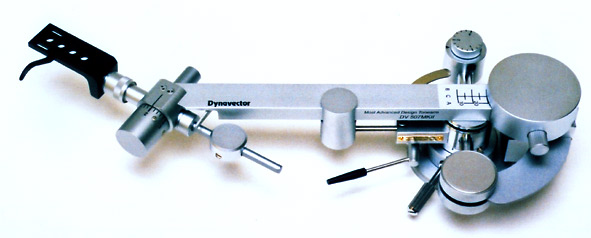Dynavector DV 507 Mk2
Dynavector DV 507 Mk2
$5,450.00
The Long-Awaited Debut of the DV507MKII
The new MKII version of the Dynavector DV 507 tonearm
has made its long-awaited debut, building on the strengths of the
original DV 507 which has enjoyed the highest reputation among
audiophiles world-wide since its appearance in 1984.
As it is a bi-axis inertia controlled tonearm the
DV 507, no matter the type of cartridge can trace the music signal
grooves cut in the recording with extreme accuracy. The DV 507
also provides superb trackability on warped recordings. Resolution
and musical detailing are quite remarkable.
![]()
| 1 | Advantages of Bi-Axis Inertia Controlled Dynamic Balance Type Tonearm |
A tone arm is required to operate
in two important ways so as to ensure that the cartridge can
reproduce faithfully the signal from the record groove.
First, there is the need to support the cartridge
so that the transfer of the cantilever motion accurately mirrors
the audio signal.
Secondly, it must maintain an excellent tracking
ability for warped records since few records are perfectly flat.
These requirements can conflict with each other.
However, the bi-axis tonearm provides an effective solution to
the problem.
| 2 | Main Features |
-Electro Magnetic Damping System for accurate tracking
|
To make the DV 507 MKII compatible with a wide variety of The DV507MKII has important sonic improvements as well as being
"Bi-axis inertia separation" may The DV507 bi-axis tone arm has a large inertia It is well known that a cartridge generates In these conditions, the signal, which causes In the currently used 45-45 stereo record cutting The tonearm therefore must have sufficient effective On the other hand, for the mid to high frequencies, To summarise, the These conditions are almost impossible to achieve To illustrate how the system works in practice,
Cartridge behaviour with two different two different In these figures line A refers to the displacement However, the DV507 shows a much better tracking
A non-contact, electro-magnetic damping mechanism
In this system, a curved rod attached to the As already demonstrated in our DV505 and
The tracking
High precision, stainless steel bearings are
Most tonearms have some frequency response
A larger arm lift has been To adjust the VTA (Vertical Tracking Angle of The anti-skating force is set using a dial indicator.
|
1 in stock
Description
The Long-Awaited Debut of the DV507MKII
The new MKII version of the Dynavector DV 507 tonearm
has made its long-awaited debut, building on the strengths of the
original DV 507 which has enjoyed the highest reputation among
audiophiles world-wide since its appearance in 1984.
As it is a bi-axis inertia controlled tonearm the
DV 507, no matter the type of cartridge can trace the music signal
grooves cut in the recording with extreme accuracy. The DV 507
also provides superb trackability on warped recordings. Resolution
and musical detailing are quite remarkable.
![]()
| 1 | Advantages of Bi-Axis Inertia Controlled Dynamic Balance Type Tonearm |
A tone arm is required to operate
in two important ways so as to ensure that the cartridge can
reproduce faithfully the signal from the record groove.
First, there is the need to support the cartridge
so that the transfer of the cantilever motion accurately mirrors
the audio signal.
Secondly, it must maintain an excellent tracking
ability for warped records since few records are perfectly flat.
These requirements can conflict with each other.
However, the bi-axis tonearm provides an effective solution to
the problem.
| 2 | Main Features |
-Electro Magnetic Damping System for accurate tracking
|
To make the DV 507 MKII compatible with a wide variety of The DV507MKII has important sonic improvements as well as being
"Bi-axis inertia separation" may The DV507 bi-axis tone arm has a large inertia It is well known that a cartridge generates In these conditions, the signal, which causes In the currently used 45-45 stereo record cutting The tonearm therefore must have sufficient effective On the other hand, for the mid to high frequencies, To summarise, the These conditions are almost impossible to achieve To illustrate how the system works in practice,
Cartridge behaviour with two different two different In these figures line A refers to the displacement However, the DV507 shows a much better tracking
A non-contact, electro-magnetic damping mechanism
In this system, a curved rod attached to the As already demonstrated in our DV505 and
The tracking
High precision, stainless steel bearings are
Most tonearms have some frequency response
A larger arm lift has been To adjust the VTA (Vertical Tracking Angle of The anti-skating force is set using a dial indicator.
|












Reviews
There are no reviews yet.